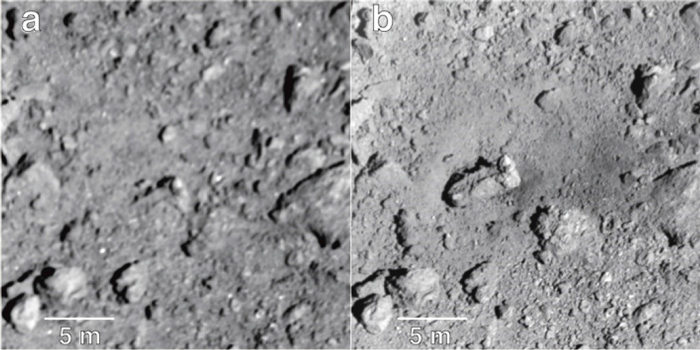The artificial impactor disturbed boulders within a 30m radius from the center of the impact crater- providing important insight into asteroids' resurfacing processes.
Professor ARAKAWA Masahiko (Graduate School of Science, Kobe University, Japan) and members of the Hayabusa2 mission discovered more than 200 boulders ranging from 30cm to 6m in size, which either newly appeared or moved as a result of the artificial impact crater created by Japanese spacecraft Hayabusa2's Small Carry-on Impactor (SCI) on April 5th, 2019. Some boulders were disturbed even in areas as far as 40m from the crater center. The researchers also discovered that the seismic shaking area, in which the surface boulders were shaken and moved an order of cm by the impact, extended about 30m from the crater center. Hayabusa2 recovered a surface sample at the north point of the SCI crater (TD2), and the thickness of ejecta deposits at this site were estimated to be between 1.0mm to 1.8cm using a Digital Elevation Map (DEM). These findings on a real asteroid's resurfacing processes can be used as a benchmark for numerical simulations of small body impacts, in addition to artificial impacts in future planetary missions such as NASA's Double Asteroid Redirection Test (DART). The results will be presented at the 52nd meeting of the AAS Division of Planetary Science on October 29th in the session entitled Asteroids: Bennu and Ryugu 2.
The aim of impacting Ryugu with a ~13cm SCI projectile was to recover a sample of the subsurface material. In addition, this provided a good opportunity to study the surface renewal processes (resurfacing) that result from an impact occurring on an asteroid with a surface gravity of 10-5 of the Earth's gravity. The SCI succeeded in forming an impact crater, which was defined as a SCI crater with a diameter of 14.5 m (Arakawa et al., 2020), and the surface sample was recovered at TD2 (10.04°N, 300.60°E) (Fig. 1). It was discovered that the crater center's concentric area, which has a radius four times larger than the crater radius, was also disturbed by the SCI impact, causing boulder movement.

Figure 1. High-resolution ONC images before and after the SCI impact. Both images are registered in an ONC latitude-longitude mosaic map.
Image credit: JAXA, The University of Tokyo, Kochi University, Rikkyo University, Chiba Institute of Technology, Meiji University, The University of Aizu, AIST.
The researchers subsequently compared surface images before and after the artificial impact in order to study the resurfacing processes associated with cratering, such as seismic shaking and ejecta deposition. To do this, they constructed SCI crater rim profiles using a Digital Elevation Map (DEM) consisting of the pre-impact DEM subtracted from the post-impact DEM (Fig. 2). The average rim profile was approximated by the empirical equation of h=h rexp[-(r/R rim - 1)/λrim] and the fitted parameters of h r and λrim were 0.475m and 0.245m, respectively. Based on this profile, the SCI crater's ejecta blanket thickness was calculated and found to be thinner than that of the conventional result for natural craters, as well as that calculated from the crater formation theory. However, this discrepancy was solved by accounting for the effect of the boulders that appeared on the post-impact images because the crater rim profiles derived from the DEMs might fail to detect these new boulders (Fig. 3). According to this crater rim profile, the thickness of the ejecta deposits at TD2 were estimated to be between 1.0mm to 1.8cm.






